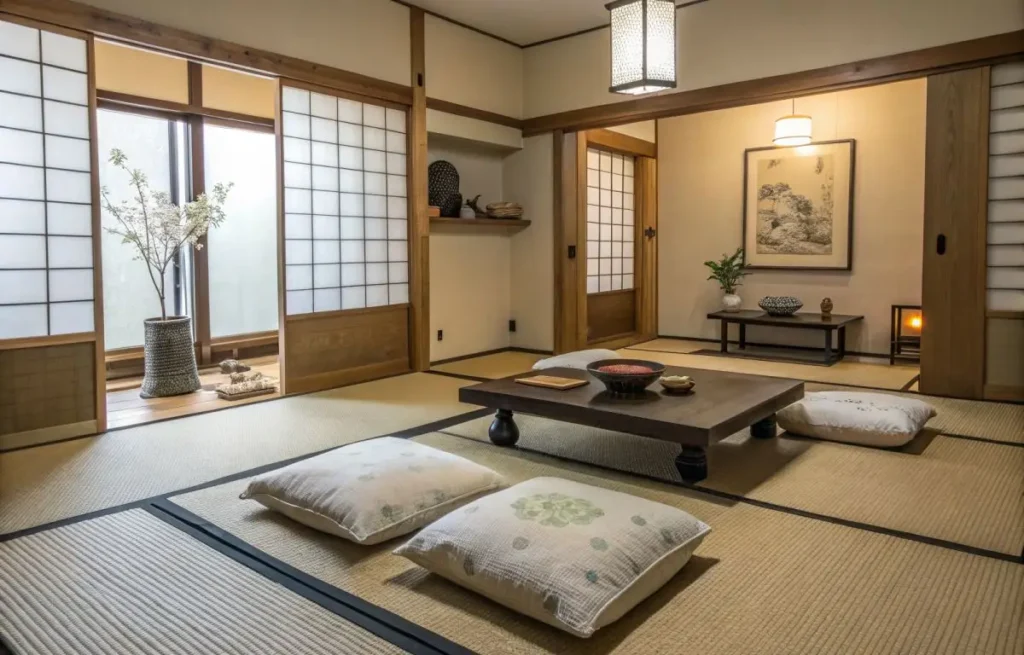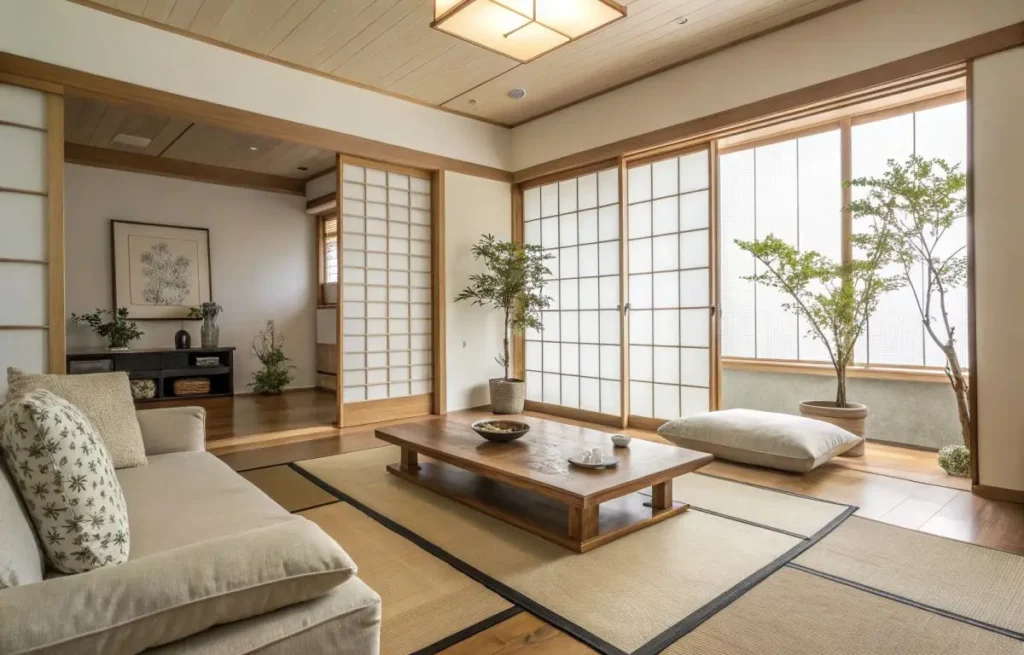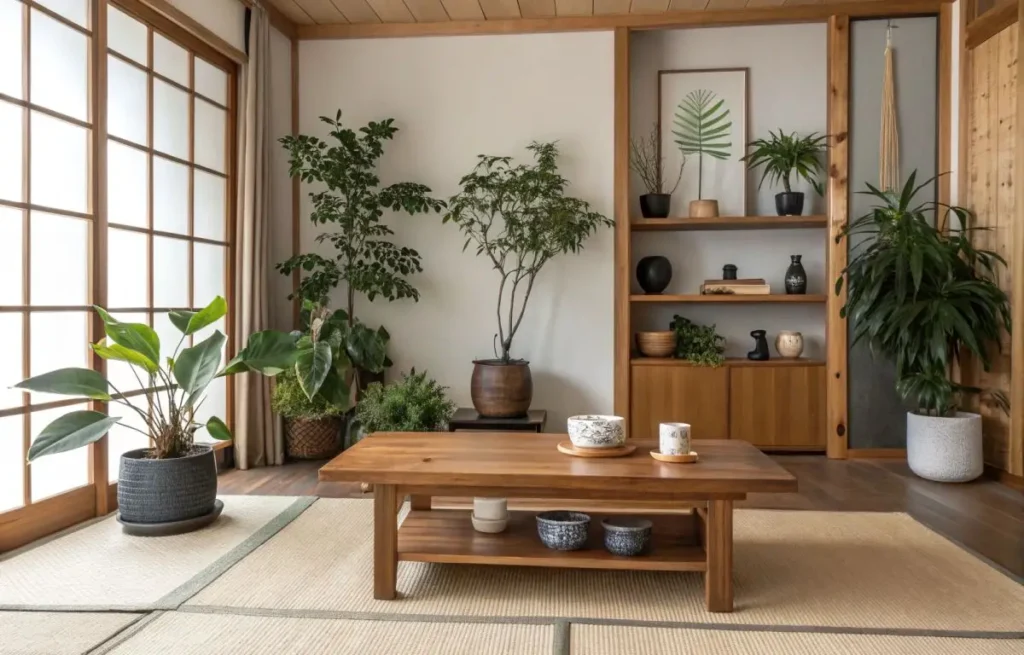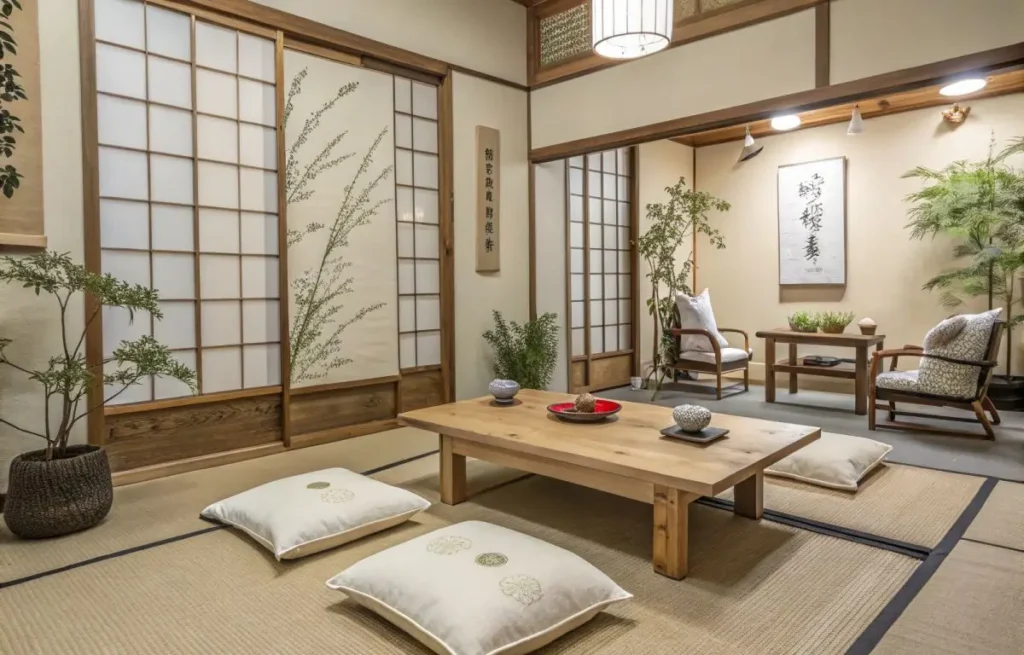Japanese home decor is more than just a design style—it’s an approach to living. It’s about creating a space where simplicity, tranquility, and beauty coexist. Whether you’re looking to redesign your home or simply introduce elements of Japanese style, the potential to transform your space into a calm and beautiful sanctuary is limitless.
But how do you do it? What are the key principles of Japanese home decor that can make your home feel like a retreat from the world? Let’s dive in and analyze how you can create the home of your dreams the Japanese way.
How to Create a Zen-Inspired Home with Japanese Home Decor
The Zen philosophy is all about harmony, balance, and a deep connection with nature. Integrating these values into your home can completely change the way you experience your living space.
Key Elements to Incorporate in Your Zen-Inspired Japanese Home Decor
To get started, it’s crucial to incorporate the fundamental elements of Japanese Zen design:
- Natural Materials: Think wood, stone, bamboo, and rice paper. Natural materials create a connection to the earth, which helps bring balance into your space. According to a study by the University of Washington, spending time in environments with natural materials can reduce stress levels by up to 30% (source: Environmental Psychology Review). Incorporating these materials in your furniture and decor isn’t just about looks; it’s about crafting an environment that helps you feel grounded.
- Neutral Color Palettes: When you think of Japanese home decor, you probably think of soft, muted tones. Colors like beige, off-white, and taupe help open up spaces and promote a sense of calm. These tones are inherently peaceful because they don’t overstimulate the senses. Studies show that neutral colors in a room can lower anxiety and encourage relaxation, which is exactly what you want in a Zen-inspired space.
- Minimalism: Less is more in Japanese decor. The minimalist approach is all about removing clutter and unnecessary items from your space. The focus is on quality over quantity, ensuring that each piece in your home serves a functional and aesthetic purpose. According to a study by Princeton University, clutter can increase stress levels, which is why a minimalist approach is so effective at promoting calmness.
Why Japanese Home Decor Promotes Calm and Peaceful Living
Japanese decor encourages mindfulness—an awareness of your surroundings and a connection to the present moment. It’s not just about creating a visually pleasing environment; it’s about designing a space that nurtures mental clarity. The simplicity of Japanese decor removes distractions and creates a space where you can feel at peace. In a world filled with constant distractions, there’s something truly special about the calming effect of a well-designed space.
How to Use Natural Materials in Japanese Home Decor for a Zen Feel
Natural materials—whether it’s bamboo, wood, or stone—bring a sense of tranquillity to any room. Consider incorporating wooden furniture, tatami mats, and bamboo blinds. Not only do these elements look beautiful, but they also help with air circulation and create a soothing, tactile environment. Shoji screens, for example, are not just aesthetic; they help diffuse light, providing a soft and calming glow that brightens up the space without being too harsh. Imagine sitting in a room where the natural light pours through a shoji screen, casting a soft glow. That’s the magic of Japanese home decor.
Essential Japanese Home Decor Pieces for a Tranquil Interior

When designing your home with Japanese elements, it’s not just about adding a few pieces here and there. It’s about selecting the right furniture and decor that will contribute to a peaceful, balanced atmosphere.
Must-Have Japanese Furniture Pieces for Tranquil Home Decor
- Low Furniture: In Japan, low-sitting furniture like low-profile sofas and coffee tables are a hallmark of the design. These pieces encourage sitting closer to the ground, fostering a sense of calm. A study by the Journal of Environmental Psychology found that low furniture can make spaces feel more open and inviting, which is exactly the vibe you want in a Zen-inspired room.
- Futons: While Western homes often feature bulky beds, Japanese homes embrace futons—simple mattresses that are placed on tatami floors at night and stored away during the day. Futons are practical and embody Japanese minimalism. They also promote a healthy, simple lifestyle that helps declutter your home and mind.
- Tatami Mats: Traditional tatami mats are made from rice straw and are often used as flooring in Japanese homes. These mats add warmth and texture to your space. While tatami may seem like an old-fashioned element, incorporating them into modern spaces can make a room feel more authentic and grounded.
How Japanese Decor Pieces Elevate Calm and Simplicity in Your Home
What sets Japanese decor apart is its focus on simplicity without sacrificing style. Every item has a function, and everything is carefully chosen for its ability to enhance the sense of calm in a space. For instance, a simple wooden coffee table or a paper lantern may seem small, but they carry immense value. These items don’t just fill space—they foster peace and promote mindfulness.
Create a Peaceful Bedroom with Key Japanese Home Decor Elements
Bedrooms are sacred spaces for rest and relaxation. With Japanese decor, simplicity is key. Use soft, neutral bedding and consider replacing bulky furniture with minimalist options like futons or low-profile platforms. Add a bonsai tree or two to bring nature indoors, and place a few tatami mats for an authentic touch. These pieces don’t just look good—they make your bedroom a peaceful sanctuary where you can truly unwind after a busy day.
Embracing Minimalism in Japanese Home Decor

In Japanese design, minimalism is more than a style—it’s a way of life. The key to achieving this minimalist look is to focus on simplicity and eliminate unnecessary clutter. When you minimize the physical clutter, you clear the mental clutter too.
Why Minimalism is Key to Japanese Home Decor’s Calm Aesthetic
Japanese minimalism is all about creating spaces that breathe and allow your mind to do the same. Research by the Clemson University School of Architecture shows that minimalist spaces can enhance creativity, reduce stress, and promote a sense of well-being. By using clean lines, natural materials, and well-placed furniture, you create a sense of balance and peace.
How to Choose Minimalist Japanese Home Decor That Stands Out
The key to minimalist Japanese decor is to choose only the items that serve both a practical and aesthetic purpose. Choose clean-lined furniture that is functional yet beautiful, like a wooden coffee table or a low-sitting couch. Don’t over-accessorize—let the quality of each piece shine. According to Architectural Digest, choosing fewer, higher-quality pieces can make a space feel more luxurious and intentional.
Achieving Serenity Through Minimalism in Japanese Home Decor
Minimalism allows for more room—both physically and mentally. When there are fewer distractions in a room, it becomes easier to relax and focus. Whether you’re working, reading, or meditating, a minimalist space encourages calmness and mindfulness. A serene, clutter-free room can significantly reduce anxiety and improve your quality of life.
Bringing Nature Inside with Japanese Home Decor

Nature plays a significant role in Japanese culture, and this extends to their interior design as well. The Japanese believe that connecting with nature helps restore balance and calm, and integrating natural elements into your home does just that.
How Japanese Home Decor Incorporates Natural Elements for a Calm Vibe
Natural materials—like wood, bamboo, and stone—are key elements in Japanese home decor. These materials create a grounded, organic feel. When used in furniture or design elements, they not only make the space more beautiful but also provide a sense of peace. Additionally, Japanese design often includes nature-inspired artwork or sculptures to bring the outdoors inside.
Using Japanese Plants to Enhance Tranquility in Your Home
Plants are an essential part of Japanese home decor. Bonsai trees, bamboo, and even simple houseplants can make a big impact. According to a Horticulture Therapy study, indoor plants can reduce stress and improve focus. When you add a bonsai tree or bamboo stalk to your living room, you’re not just decorating—you’re cultivating a sense of calm.
The Role of Natural Light in Japanese Home Decor and Serene Spaces
Natural light is one of the most important elements in Japanese design. Large windows, light curtains, and shoji screens allow soft, natural light to filter into the home, which creates a peaceful atmosphere. Studies show that natural light can improve mood, boost productivity, and promote better sleep, which is why it’s so integral to Japanese decor.
Color Palettes for a Calm and Beautiful Japanese Home

Colors influence the mood of a room. The right colour palette in your home can create a tranquil environment that encourages relaxation and mindfulness.
Choosing the Right Colors for Your Japanese Home Decor
Japanese homes typically feature soft, neutral colour palettes. Shades like pale grey, taupe, and off-white are common. These muted tones create a sense of space and calm. According to the Journal of Environmental Psychology, soft colors can help reduce anxiety and promote a sense of tranquility.
How Japanese Color Palettes Contribute to a Calm, Beautiful Interior
Japanese colour palettes reflect nature—earthy tones like browns, greens, and muted blues mirror the colours of the outdoors. These colours make spaces feel more open and serene, helping you connect with the environment. In fact, incorporating these shades can help foster a peaceful atmosphere, whether you’re in the living room, bedroom, or even the kitchen.
Incorporating Neutral Colors in Japanese Home Decor for Serenity
Neutral colors are a staple of Japanese design. They allow other elements in the room—like wood, stone, and greenery—to shine. These colours don’t overwhelm the senses but instead, let the beauty of the natural materials to take centre stage. Whether it’s a beige wall or a light grey couch, neutral colours foster a peaceful environment and encourage relaxation.
Conclusion
Japanese home decor is all about simplicity, balance, and a deep connection with nature. By incorporating key elements like natural materials, minimalist furniture, and serene colour palettes, you can transform your home into a peaceful sanctuary. Whether you’re designing a new space or just adding a few Japanese-inspired touches, the principles of Japanese decor can help create a home that’s not only beautiful but also promotes calm and well-being.
By following these principles, you can design the calm, beautiful home of your dreams—one that brings you the peace, relaxation, and tranquillity you deserve.
FAQs
- What is Japanese home decor?
Japanese home decor emphasizes minimalism, natural materials, and a connection with nature. It creates a tranquil, serene environment focused on simplicity and mindfulness. - How can I make my home feel like a Japanese-style retreat?
To create a Japanese-style retreat, use neutral color palettes, incorporate natural materials like wood and bamboo, and keep furniture low-profile and minimalist to enhance the feeling of calm. - What furniture pieces are essential for Japanese home decor?
Key pieces include low-profile furniture, futons, tatami mats, and minimalist wooden furniture, all of which contribute to a peaceful, clutter-free space. - What are the benefits of a Zen-inspired home?
A Zen-inspired home promotes relaxation, reduces stress, and enhances mindfulness by focusing on simplicity, balance, and natural elements in the decor. - How do natural materials contribute to Japanese home decor?
Natural materials like wood, bamboo, and stone help bring warmth, texture, and a grounded feel to a space, promoting a sense of connection to nature and tranquility.
People Also Read

